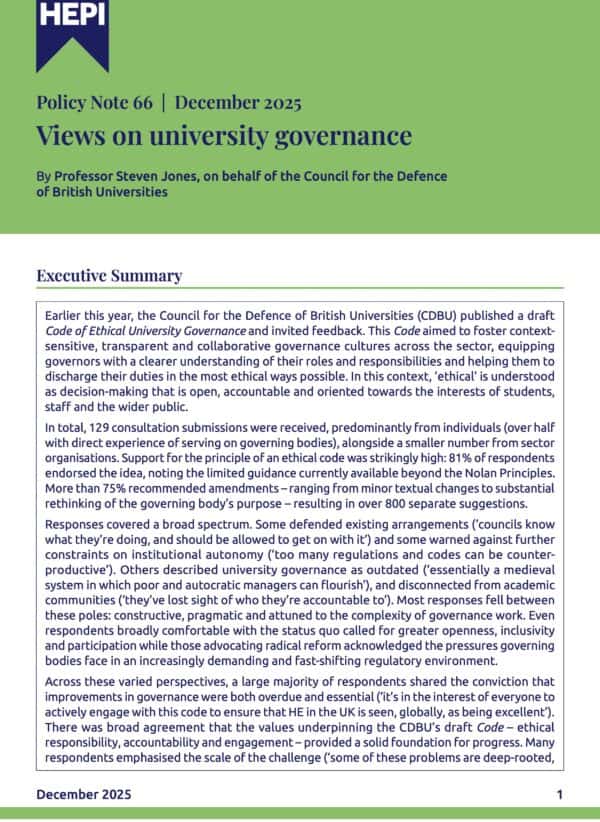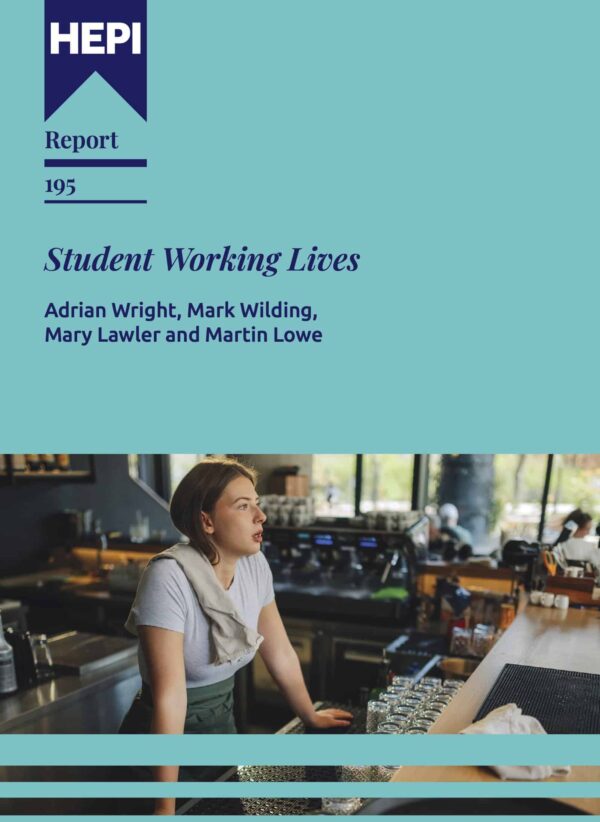WEEKEND READING: ‘Overstretched and under-resourced’? UK higher education on the cusp of the Spending Review
This is the text of a speech Nick Hillman delivered this week at the University of Bradford.
Thank you for inviting me back to Yorkshire, and indeed to the bit of Yorkshire that sometimes feels like it has more universities per head of the population than anywhere else in the UK. Although HEPI is based in Oxford, I come up here regularly and, indeed, have made two separate trips this week alone – one to Leeds on Monday and Tuesday and this one to Bradford on Thursday and Friday. I am only sorry that I could not enjoy West Yorkshire’s warm hospitality for the whole week.
HEPI’s recent output
For those of you who may be new to my employer – HEPI or the Higher Education Policy Institute – we are the UK’s only specialist think tank for higher education and a registered charity. Founded in 2002, our 25th anniversary will soon hove into view. Our goal is to prompt evidence-based conversations about higher education policy through engagement, publications and events. We are funded by most universities throughout the UK and a limited number of corporations which want UK higher education to thrive.
We are perhaps most well known for our written output and, since the start of this calendar year alone, we have published 10 pieces of new research.
In January, we published some:
- student polling on rises in tuition fees and increases to maintenance support –which showed, perhaps unsurprisingly, that the former is more palatable to students if accompanied by the latter; and
- a detailed report on universities’ reaction to the student encampments set up in response to the situation in the Middle East – which sought to explain why, despite the difficulties, most notably for Jewish students, these were not generally as fraught as some of those in the US.
In February, we published:
- a paper on the Curriculum and Assessment Review, which we feel the higher education sector should pay more attention to, and what the Review might mean for higher education institutions – our work showed a clear regret among today’s undergraduates that they had not received more PSHE, for example financial information, while at school / college;
- a look back over the past few decades of higher education policy from the longest-serving vice-chancellor in the country, Dr John Cater of Edge Hill University across the border in Lancashire (sorry!); and
- a study of students’ use of generative AI – you may have heard this cited on this morning’s Today programme on Radio 4 as evidence for the explosion in students’ use of AI.
In March, we published:
- an analysis by Professor Peter Mandler, a Cambridge History don, on The Swing to Science – which suggests both the push of policymakers to get more people into science as well as other important factors have had some success in increasing STEM take up since the turn of the millennium;
- a high-profile report that I co-authored on the educational underachievement of boys and young men – which is an issue that, after many years of trying by HEPI and others, is finally beginning to be understood better; and
- a look at the new Skills England body which considers all the ‘known unknowns’ about that new body – this suggested, ‘The best-case scenario’ is one in which ‘Skills England generates and distributes high-quality data on skills shortages and labour markets at national, regional and sub-regional levels, [and] which galvanises employers and providers to work closer together through a shared understanding’, but the author, Tom Richmond, also warned about the possibility of a ‘worst-case scenario’ in which ‘Skills England struggles to become a respected voice within government and is largely ignored by other departments and organisations who see little value in engaging with it’.
And in April, we published:
- in conjunction with the University of Bristol and Advance HE, a paper on whether or not students and graduates feel, with the benefit of hindsight, that they made the right decisions about their own higher education; and
- last week, a detailed look at whether employers should be paying more of the costs of higher education by Professor David Phoenix, the outcoming Vice-Chancellor of London South Bank University and the incoming Vice-Chancellor of the Open University.
If you are not yet on our mailing list, please do get in touch and ask us to sign you up. There is no cost, as your institution’s donation to our work helps pay for what we do. Indeed, I think we are going to be the last organisation standing when it comes to producing hard copies. Our goal is that the latest HEPI report will be the first thing you see when you go into a vice-chancellor’s anteroom – though we obviously do electronic copies too.
And do sign up for our daily blog: in the last few days alone, this has covered student accommodation, advice for applicants, support for Chinese students in the UK, collaboration, free speech, the degree-awarding gap and the crisis in teacher supply.
The policy environment
I was asked to talk about the policy environment and to do a sort of horizon-scanning piece. The obvious place to start is with the ministerial upheaval we have lived through.
- In my 11 years at HEPI, the Minister for Universities position has changed hands 11 times (though even this underestimates the true scale of the changes, as two individuals have done the job twice in that time).
- And the Minister for Science and Research, which used to be the same person as the Minister for Universities before (sadly) the roles were split across two people sitting in two different government departments, has changed hands even more often: 12 times (with one person doing the job twice and the role also being subject to a short period when no one filled it).
My current favourite pub-quiz question for university audiences is: who was the Minister for Higher Education this time last year? Even knowledgeable audiences tend not to know. The answer is Luke Hall. The current incumbent, Baroness (Jacqui) Smith has already spent three times as long in post as he did – and she is about to overtake the time Sam Gyimah and Greg Clark each did the job for. (Despite the rapid turnover in Ministers and because Jacqui Smith sits in the House of Lords, there is currently only one Member of the House of Commons who has served as the Minister for Universities – that is the Foreign Secretary, David Lammy – thanks to the clear out of MPs at the election.)
The ministerial turnover we have witnessed makes long-term planning difficult. Furthermore, it is notable that, although Jacqui Smith and her fellow peer the Minister for Science, Lord Patrick Vallance, have been in post for 10 months now, they still feel like a new broom. This is largely because – unlike many incoming ministers after the 2024 election – neither had shadowed their areas from Opposition. He may have become a public figure in the pandemic, but Patrick Vallance was not even a party politician back then.
Even though we are still itching to know what this Government’s long-term legacy on higher education will be, the last few months have nonetheless seen lots of activity affecting higher education institutions, staff and students.
These include:
- a new interim Chair of the Office for Students and the appointment more recently of a new permanent Chair in Professor Edward Peck, currently Vice-Chancellor of Nottingham Trent University;
- the Renters (Reform) Bill, which is altering students’ rights as tenants and may affect the supply of accommodation for students;
- the pause then partial unfreeze of the previous Government’s legislation on free speech and academic freedom in higher education;
- a long overdue tuition fee increase, which would be great if it were not for the fact that every penny of that and more is going back to the Exchequer in higher National Insurance Contributions;
- a halt in the supply side, meaning if you are an up-and-coming new provider of higher education, you cannot currently apply to be on the Office for Students’ Register, nor for Degree-Awarding Powers or University Title; and
- a crackdown on franchised provision and a promise from the Secretary of State for Education, Bridget Phillipson, to ‘bring forward new legislation at the first available opportunity to ensure the Office for Students has tough new powers to intervene quickly and robustly to protect public money.’
The Secretary of State was, to be fair, focusing on the specific issue of franchising, where there have been some severe problems (and where we at HEPI have previously called for more regulation ourselves), but I doubt many university managers or governors currently feel the biggest problem facing the sector is that there are insufficient powers vested in the Office for Students. And remember, once you put a specific piece of legislation in front of Parliament focused on changing the Office for Students’s powers, there will be plenty of scope for MPs and peers to add their own hobbyhorses – making it, to mix my metaphors, something of a Christmas-tree bill on which everyone’s favourite baubles can be hung.
All this means that, aside from the give-with-one-hand-and-take-with-the-other fee rise, there have not yet been any significant recent changes on higher education funding or student finance. And given three-quarters of higher education providers are expected to be in deficit in 2025/26, the one area that always comes up in any higher education conversation at the moment is the deteriorating financial position of institutions.
The funding crisis – for institutions and students
According to Mark Corver of DataHE, the maximum full-time undergraduate tuition fee, which was raised to £9,000 in 2012 and is currently £9,250, is now worth just £5,714 in real (2012/13) terms. That is the same level as when John Major felt it necessary to set up the Dearing review, with the agreement of Tony Blair in Opposition, leading to the (re)introduction of tuition fees from 1998.
In contrast, per-pupil spending in state schools is rising and is approaching £8,000. Once capital spending for schools is added in, it goes up further. So it is clear that the amount of income for educating each home undergraduate (outside the really expensive subjects that still attract grant funding on top, such as Engineering) is now only a little greater than the amount spent educating secondary school pupils, and the two could soon crossover, as student funding has been declining while per-pupil school funding has been increasing.
Traditionally, there has been a large gap between these two numbers because it was thought it cost a lot more to educate someone to a higher level in a university setting than to, say, GCSE level in a school. Policy suggests that is no longer taken as read, but surely we need a proper debate about such a profound change in assumptions about the cost of different forms of educational provision?
I spent some of the Easter break reading a book from the US on student funding, Making College Pay: An economist explains how to make a smart bet on higher education by Beth Akers, which is a powerful reminder that it is not only how much you pay but what you get out of it that determines if your higher education turns out to be good value for money. On this score, Bradford performs perhaps better than anywhere else: since 2021, HEPI has published an annual Social Mobility Index with London South Bank University, with the most recent iteration appearing in December 2024. The Index combines the social distance travelled by socio-economically disadvantaged graduates from each higher education institution with the proportion of graduates so transported, and is based on access, continuation and outcome measures. Bradford has come top in every single year. Congratulations on this extraordinary achievement.
It is too easily forgotten by today’s policymakers that institutions like Bradford and your fellow Colleges of Advanced Technology became universities in a previous period of concern that we were not keeping up with other developed countries. So to underfund places like Bradford now when we are again concerned about the UK’s global competitiveness makes no sense.
One possible response to the funding crisis faced by the sector is to ‘pile ‘em high and sell ‘em cheap’, for example, by significantly worsening the staff:student ratio, as in the 1980s and 1990s. But there are two problems with this: first, we are already selling students cheap, cheaper than at any other point before, other than the period immediately preceding the Dearing report; and secondly, demand for higher education is softening.
Generally, the main drivers of demand, at least among young full-time school leavers, are the number of 18-year olds in the country and the proportion of them that have the skills, qualifications and aptitude to make it in higher education. The number of 18-year olds is growing year-on-year at the moment and setting aside the COVID-related grade inflation and subsequent grade deflation, their school performance is relatively strong. Plus there are groups in society that are still severely under-represented in higher education, meaning there is plenty of room for further growth. That is why HEPI’s many reports on demand have generally been optimistic about the possibility of further growth in student numbers.
No one is quite sure why demand is currently static or down against past expectations as a proportion of school leavers, but it seems to me that the two most likely causes are: the cost-of-living affecting students, whose maintenance packages have not kept up with anything like the true cost of being a student, affecting the student experience and meaning that most (57%) full-time students now feel they have no choice but to do paid work during term time; and the negative rhetoric about higher education that has been ceaselessly pumped into the COVID generation.
Just the other day, it was reported that Jonathan Hinder, the Labour MP for Pendle and Clitheroe, has said we have too many universities and too many students and that he is ‘not that disappointed’ about the prospect of universities going bust. This week, we have also had a piece in a national broadsheet newspaper from the Conservative commentator Henry Hill titled ‘Our bloated university sector has set up Gen Z for failure’. This repeated the rumour that nurses with degrees are ‘less prepared’ to empty bedpans while ignoring the hard evidence from around the world showing patients are less likely to die in hospitals that have a higher percentage of graduate nurses. Incidentally, the best thing to do with such journalistic attacks is to look up the background of the author. They always, without exception, have at least two degrees to their name – even the education-sceptic news outlets reserve their column inches almost exclusively for those with an impressive array of post-nominals.
Some years ago, I helped to popularise the idea that traditional UK higher education is delivered on a ‘boarding school model’, at least for young full-time middle-class school leavers. Having spent my entire childhood in boarding schools – even in the school holidays as my parents worked in that sector – it seemed to me as if the all-round residential education many UK universities sought to offer resembled a traditional English boarding school in important respects. But in a world where most students have to do paid work on the side, with little or no time for extra-curricular activities, and where the combined maximum annual maintenance and tuition loans of undergraduates amount to around £20k a year (when boarding schools can now cost £60k a year), this analogy has lost its utility for describing the mainstream student experience. It is only the minority, the very best-off students, who can live the traditional student experience. Something has clearly gone wrong because, as the country has got richer, the student experience has become poorer.
Insolvency
One specific issue related to institutional funding that comes up in every meeting on higher education I go to is what happens if and when a university goes bust. Currently, nobody knows for sure because, in the 800 years of higher education in England, no university has ever gone under (though some have got close, mergers have occurred and some ‘alternative’ higher education institutions without University Title have disappeared). Yet one thing we do know is that students will be low on the priority list if a major institution does have to close.
Last year, we conducted a poll among students to ask them what they think should happen, starting with the question: ‘How worried are you that your own higher education institution might go bust?’ Very few undergraduates are ‘very worried’ their university will go under. But 37% of men are ‘quite worried’ along with 17% of women, meaning men are a lot more worried than women.
Looking at the numbers by mission group, students at Russell Group institutions are much less likely to say they think their university will go bust and I guess they are probably right about that. The ones who are most worried are students at other pre-92 institutions and specialist institutions, which – as always with student polling – confirms they have a good understanding of what is going on.
We also asked: what do you think should happen if your university does go under? Intriguingly, but perhaps not surprisingly, the most popular answers were all to do with the government helping out. So the top answer was a government bailout and the second most popular answer was a refund of students’ tuition fees, presumably on the grounds that their education has not worked out so well.
The least popular answer (apart from ‘None of the above’) was selling the institution to a foreign company, which only 8% of students think is reasonable. And yet British Degree-Awarding Powers and University Title are worth their weight in gold so are of huge interest to people around the world and we will need to know soon whether the Government would accept a foreign takeover or not because, as I know from my own experience as a university governor, there are many such companies sniffing around.
All of this is getting closer to home because the University of Dundee has already fallen over and, as was widely expected, the authorities have had to find some public money to bail it out. That is probably a good thing – no one wants to see Dundee disappear. It is one of the biggest employers in the area and is number one in the UK for Biological Science research. But the bailout is creating a major problem of moral hazard because, once you have helped out one institution like this, there is a disincentive on governors and managers at other universities to tackle the challenges they face – or for unions to accept them.
It will be interesting to see if Alan Langlands’s report into the problems at Dundee will lay the blame at the door of Scottish policymakers, for they have been incredibly timid when it comes to funding universities properly. I am not holding my breath but the Scottish political parties’ response to Dundee’s problems should start by questioning whether it makes any sense to stick with Scotland’s ‘no fees’ policy, especially when it also means tight student number caps. I am looking forward to taking part in an event hosted by the Royal Society of Edinburgh in a few days’ time to consider the wider questions of higher education funding in Scotland in the run up to the elections to the 2026 Scottish Parliament.
What would you do?
We stand on the cusp of a major Spending Review and a long-promised higher education reform programme, so it is fair to ask: what would you do? At HEPI, we have published lots of ideas on reforming higher education finance, including in our multi-authored collection published in April 2024, or in former Treasury official Tim Leunig’s HEPI paper from September last year or in our most recent publication out last week (which I have already mentioned) in which Dave Phoenix seeks to unlock a greater financial contribution from graduate employers towards the costs of the higher education from which they benefit.
However, even if such ideas are wise, big reforms take years to implement whereas institutions and students are suffering now. While in Opposition Bridget Phillipson, the Shadow Secretary of State for Education, promised to ‘change the way students pay for their time at university’. So the time is ripe for some more rapid changes and, if it were me, I would want to investigate making five changes now.
1. First, I would commit to increase tuition fees by inflation plus (that is, inflation plus a little more, perhaps 1% or 2% a year) for a minimum fixed period of time, meaning at least every remaining year of the current Parliament but ideally for 10 years, to enable longer term planning and to ensure our universities can recover their world-class status. We talk about a 10-year funding strategy for research and development (R&D), so why not a 10-year strategy for teaching income too? Personally, I would be inclined to match this with a quid pro quo in the form of greater expectations on universities to provide information on contact hours and workload, post-graduation earnings (as proposed in a recent HEPI blog by one of undergraduate interns, Joseph Morrison-Howe) as well as – with an eye on Nigel Carrington’s Transformation and Efficiency Taskforce for Universities UK – the use of income from tuition fees. Others might expect any fee rises to be linked to metrics like the Teaching Excellence Framework.
2. Secondly, I would raise student maintenance support so that it more closely matches the term-time needs of students, ideally with the return of maintenance grants for the poorest students as exist in all other parts of the UK. We have calculated that students need over £18k a year to live whereas they typically receive a little over £10k, but it is not feasible to assume the Government will fill in the whole gap of this and it is not unreasonable to expect students to work during their holidays, for example. There are also some possible ways to put more ready cash in the pockets of students by limiting the cost of being a student, such as innovative and more cost-effective student accommodation options (as outlined in a recent HEPI Policy Note by the Yorkshire-based student accommodation expert Martin Blakey) as well as encouraging more informed decisions by students on their accommodation preferences.
3. Thirdly, I would reintroduce a real rate of interest on the student loan debts of better-off graduates. The removal of the real rate of interest by the Boris Johnson Government removed a progressive and hard-won feature of the student loan system that ensured those who did best from their higher education paid back a little more (by virtue of the fact it took them longer to extinguish their debts). The student loan system looks after you by writing off your loans if you do not do well financially after university, so under the insurance principle it is only fair that you pay back a little bit more when you do succeed in monetary terms. When the real rate of interest was removed, Labour opposed the change, so they are well placed to reimpose something like it. And I note that only last week the National Union of Students published some modelling with London Economics based on the introduction of real interest rates post-graduation of between 0% and 2% (lower than in the past) for graduates with earnings of between £27,571 and £57,570. I do not claim higher interest will be popular but something has to give and the idea that higher education is about to receive a financial windfall in the Spending Review is for the birds.
4. Fourthly, I would look to simplify graduate repayments. The Student Loans Company has been in the news recently because its systems are close to the edge. A headline in The Timesscreamed, ‘Student loans system “on brink of collapse” due to outdated IT’. It is a long-term problem: when I worked in Government over a decade ago, the SLC had to buy parts of its IT system on eBay. Indeed, sadly, not much has changed from the days when back in the 1990s the SLC inputted my personal details incorrectly because they paid a contractor by the number of people whose details they inputted rather than by the accuracy of the data. Yet today, the SLC manages a loan book of £260 billion and has 10 million customers; each year, it processes around 2 million applications, pays out £23 billion and works with nearly 1,500 education providers. What was originally set up as a small organisation to process mortgage-style maintenance loans to undergraduates on a single basis across the whole UK has become, 35 years later, a behemoth serving each part of the UK separately, paying out fees as well as maintenance and serving FE students and postgraduates as well as undergraduates: five years ago, the SLC had 86 product variants and the number has surely grown since then, for example with the introduction of Plan 5. Moreover, the SLC’s responsibilities will become a whole lot more complicated still when the Lifelong Learning Entitlement comes on stream. Yet as that story in The Times also confirmed, there remains no appetite in the Government for funding the SLC appropriately for the job it has to do. So in my view the time has come for something radical. I would copy what happened to pensions taxation when, on so-called A-Day in April 2006, eight different pension tax regimes, which had accumulated over time like archaeological layers, were swept away in preference for one simpler regime which has (largely) stood the test of time. While I recognise this analogy may not be perfect and also that student finance is a devolved matter and so not in the sole control of Whitehall, I would aim to compress the multiple student loan repayment plans into, ideally, one – making like simpler for graduates and employers as well as the SLC.
5. Fifthly, I would either reverse or else recognise the logic of the new ministerial, regulatory and departmental arrangements. In the past, we had one Minister, one Department and one Regulator for both the teaching and research functions of universities. This reflected the secure belief that teaching and research benefit each other (covered in another recent publication of ours). But whether we like it or not, the world has changed: teaching and research were split across two Whitehall Departments in 2016, two Regulators in 2018 and two Ministers in 2020. If Ministers increasingly expect tuition fees to be spent on students only, for their policies undoubtedly assume that international fees must now cross-subsidise a better experience for home students, then they need to recognise those cross-subsidies are no longer so available for subsidising research. The consequence is they need to fund research better as part of the long-promised 10-year R&D funding plan if they want universities to play their full part in delivering economic growth. They also need to confront the question of what happens to those institutions that are less able to attract large numbers of foreign students to cross-subsidise the costs of their home students, especially now franchising has fallen out of favour. We can talk all we like about joined-up government but, in our area, it is clear that the opposite has been the goal of those in power – if it were not so, they would have kept teaching and research together, whether in their own department (as in the days of DIUS under Gordon Brown’s early stint in Number 10), or in another department (such as the Business Department in Brown’s later days and the time of the Coalition), or in a new department, like the current DSIT.
I am going to draw my remarks to a close now. There are lots of issues I have not touched upon but I have sought to address:
- what HEPI does, and what research we have published so far in 2025;
- the high level of ministerial turnover and the wider political turbulence affecting higher education in recent times;
- the decisions that this Government have already made on higher education in its first few months;
- the severe and growing shortfall in resources for teaching in higher education;
- softening demand for higher education among the COVID generation of pupils and the possible reasons behind this;
- the likelihood of institutions going bust and what students think should happen if this occurs;
- the changes I would make if I were the Minister for a day, including raising fees and maintenance, reimposing a progressive and real rate of interest on student loans, harmonising repayment rules for different cohorts of graduates with debts and suggesting policy should come to reflect the logic of the split in teaching and research now evident in Whitehall and among regulators – or else ending the split by bringing teaching and research back together.
I am happy to take any questions.







Comments
Paul Wiltshire says:
Given that the large majority of graduates don’t use what they have learnt in their degrees in their careers to any real meaningful extent, then we need to stop the nonsense that drives so many of our young adults into getting into a lifetime of debt for a pointless extra three years of study.
So the solution is very simple – reduce participation down to between 15-30% made up of those most likely to benefit based on academic ability, and then more young adults should enter the workforce aged 18 and gain work experience and training to further their careers.
Reply
Add comment